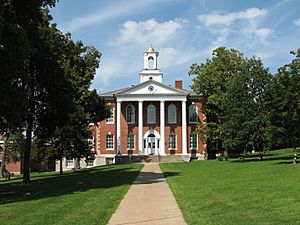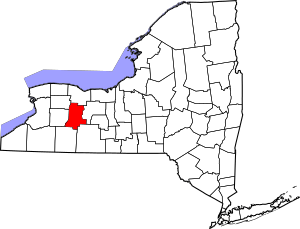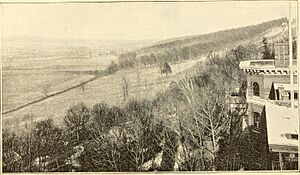Livingston County, New York facts for kids
Quick facts for kids
Livingston County
|
|||
|---|---|---|---|

Livingston County Courthouse
|
|||
|
|||

Location within the U.S. state of New York
|
|||
 New York's location within the U.S. |
|||
| Country | |||
| State | |||
| Founded | 1821 | ||
| Named for | Robert R. Livingston | ||
| Seat | Geneseo | ||
| Largest village | Geneseo | ||
| Area | |||
| • Total | 640 sq mi (1,700 km2) | ||
| • Land | 632 sq mi (1,640 km2) | ||
| • Water | 8.5 sq mi (22 km2) 1.3% | ||
| Population
(2020)
|
|||
| • Total | 61,834 | ||
| • Density | 97.9/sq mi (37.8/km2) | ||
| Time zone | UTC−5 (Eastern) | ||
| • Summer (DST) | UTC−4 (EDT) | ||
| Congressional district | 24th | ||
Livingston County is a county in the U.S. state of New York. In 2020, about 61,834 people lived here. Its main town, or county seat, is Geneseo. The county is named after Robert R. Livingston, who helped write the Declaration of Independence. He also helped with the Louisiana Purchase. Livingston County is part of the beautiful Finger Lakes region of New York. It is also part of the larger Rochester area.
Contents
History of Livingston County
When New York State first created counties in 1683, the land that is now Livingston County was part of a huge area called Albany County. This county was enormous, stretching all the way to the Pacific Ocean in theory!
Over many years, this large area was divided into smaller counties. In 1772, Albany County was split, and the western part became Tryon County. This new county was named after the colonial governor, William Tryon. After the American Revolutionary War, in 1784, Tryon County was renamed Montgomery County. This honored General Richard Montgomery, a hero who died fighting in Canada.
Later, in 1789, Ontario County was created from Montgomery County. This new Ontario County was also very large, covering much of western New York. Then, in 1802, Genesee County was formed from Ontario County.
Finally, in 1821, Livingston County was officially created from parts of Genesee and Ontario Counties.
Today, Livingston County is home to SUNY Geneseo, a well-known college.
Seneca People and Early Settlers
The Seneca Nation of Indians were a very important group among the Six Nations. They were known as the "Keepers of the Western Door" because they protected the western lands of the Iroquois. Many of their main towns were in the fertile Genesee Valley, which is now part of Livingston County. One of their biggest towns was Little Beard's Town, located near what is now Cuylerville.
The Sullivan Campaign during the Revolutionary War
In 1779, during the American Revolutionary War, General George Washington sent General John Sullivan on a big mission. Sullivan's army of about 5,000 soldiers marched into Seneca territory. Their goal was to destroy Seneca settlements and farms. This was to stop the Iroquois from helping the British.
On September 13, 1779, a group of Sullivan's scouts were ambushed near Conesus Lake. At least 16 Americans were killed. This spot is now called the Ambuscade. Sullivan's army found the Seneca villages empty, as most people had moved west to Fort Niagara. The army then burned the villages and thousands of acres of crops.
After destroying over 40 Native American settlements and food supplies, Sullivan's army returned. This mission helped make the area safer for white settlers. The soldiers' stories about the beautiful Genesee Valley encouraged many new settlers to move there after the war ended in 1783.
Treaties with the Seneca People
Even though their villages were destroyed, the Seneca people still owned their land. To allow more settlers to move west, a series of treaties were made. These treaties changed the Seneca culture forever.
After the Revolutionary War, two men, Phelps and Gorham, bought rights to about eight million acres of land from Massachusetts. They then made a treaty with the Seneca to claim this land. About two-thirds of Livingston County was part of this deal.
Later, Robert Morris, a key figure in the American Revolution, bought much of this land. He then sold most of it to the Holland Land Company. Morris was supposed to get the Native American title to the land removed.
The 1794 Treaty of Canandaigua recognized the Six Nations' ownership of their lands in western New York. But as more settlers wanted land, the Treaty of Big Tree was signed in 1797. This treaty included the western part of Livingston County. It removed Native American claims to almost all the land west to the Niagara Frontier, except for a few reservations.
The Pioneer Wadsworth Family
Colonel Jeremiah Wadsworth was a very rich and powerful man after the Revolutionary War. He invested a lot in land in this area. In 1788, he visited the Genesee country and found it incredibly rich. He bought over 200,000 acres along the Genesee River.
Colonel Wadsworth offered his young cousins, James and William Wadsworth, 2,000 acres of prime farmland near what is now Geneseo. In return, they were to set up a home farm and encourage others to settle there.
The Wadsworth brothers bought thousands more acres, becoming the biggest landowners in western New York. They rented most of their land to tenant farmers with fair agreements. James and William were known for their kindness and new farming ideas. The Wadsworth family's legacy and their large land holdings are still important in the Genesee Valley today.
Genesee Valley Canal
When the Erie Canal opened in 1825, it brought great success to New York. People realized how useful canals were for moving goods. The Genesee Valley needed a way to connect to bigger markets. So, planners decided to build a canal through Livingston County. This canal would connect the Erie Canal with the Allegany River, linking to the Ohio and Mississippi Rivers. This would allow goods and people to travel all the way to New Orleans.
Construction of the Genesee Valley Canal began in Rochester in 1837. It reached Mount Morris by 1840. A branch to Dansville opened in 1841. Building the canal through Nunda and Portage was very hard because of the rugged land along the Genesee River gorge. After many delays, 17 locks were finished in 1851.
However, by the time the canal was fully completed in 1862, railroads had become much more popular. The Genesee Valley Canal closed by 1878. Its old towpath became the path for the Genesee Valley Canal Railroad. Railroads quickly became the main way to travel and transport goods across the county. Even though the canal was short-lived, it created many jobs for new immigrants and helped the area's economy.
Today, the old Genesee Valley Canal Railroad path is part of the Genesee Valley Greenway Trail, a popular trail for walking and biking.
Important Sites and Events
Genesee Wesleyan Seminary, Lima
One of the first schools in the country that allowed both boys and girls to study together was the Genesee Wesleyan Seminary. It was started in 1834 by the Methodist Episcopal Church and operated until 1941. Genesee College, which began at the same place in the 1840s, later moved and became Syracuse University. Today, Elim Bible Institute is located there.
Water Therapy: Avon Springs and the Jackson Sanitarium
The area around Avon was known by the Seneca people as "Canawaugus," meaning "the place of stinking waters." This was because of the sulfur in the springs. The Seneca believed these mineral waters had health benefits. In 1821, Richard Wadsworth was the first white settler in Avon to promote the healing power of the sulfur water. Avon Springs became very famous in the 1800s, attracting visitors seeking health cures and relaxation. By 1900, most of the many hotels and spas were gone.
Dansville also had mineral springs. The most famous was a large resort run by Dr. James C. Jackson. He was a leader in holistic health and an abolitionist. Dr. Jackson invented Granula, America's first cold breakfast cereal. He also encouraged exercise and more comfortable clothes for women.
During World War I, the sanitarium was used as a hospital for wounded soldiers. In 1929, bodybuilder Bernarr Macfadden bought the place and called it the Physical Culture Hotel. His fame made the hotel popular until the 1950s.
The Shakers of Groveland
The only Shaker community in western New York started moving to Sonyea in Groveland in 1836. Shakers lived a simple life, practicing celibacy and sharing everything in their farming communities.
Their farm was 1,700 acres and had fertile land. It was also close to the Genesee Valley Canal, which helped their small businesses. They made brooms, dried apples, dried sweet corn, and fancy items like sewing boxes.
The Shaker population in Groveland was largest in 1836 with 148 members. By 1892, only 34 members remained, and they moved to another Shaker community. After the Shakers left, the State of New York bought the land and buildings. They used it to create the Craig Colony for Epileptics, a special hospital.
Civil War Regiments
Three Civil War army groups were formed in Livingston County. The 104th New York Volunteer Infantry, also called the ‘Wadsworth Guards’, was created in September 1861 in Geneseo. It was named after General James S. Wadsworth.
Two other regiments were formed in Portage. In 1862, the 130th Infantry regiment was created. It later became a cavalry unit known as the 1st New York Dragoons. In the same year, the 136th Infantry Regiment, also called the ‘Ironclads’, was organized.
The Caledonia Fish Hatchery
Rochester native Seth Green was a pioneer in raising fish artificially. His work led to the creation of the first fish hatchery in the Western Hemisphere in Caledonia in 1864. This hatchery is still active today and is managed by the Department of Conservation.
Genesee Valley Hunt
The Livingston County Hunt was started in 1876 by Major William Austin Wadsworth. By the early 1880s, it was called the Genesee Valley Hunt. The area became famous as a center for fox-hunting in North America. The Genesee Valley Hunt is still active and is one of the oldest in the U.S.
Salt Mining
Salt was found more than 1,000 feet underground in Livingston County in the early 1880s. Salt mines opened in towns like Leicester, Livonia, Mount Morris, and York (Retsof). The Retsof mine became the largest salt mine in the United States and the second largest in the world. This industry provided many jobs for most of the 20th century. However, the mine collapsed and flooded in 1994.
In 1997, American Rock Salt opened a new mine in Groveland. It quickly became the largest working salt mine in the U.S.
Murray Hill, Mount Morris
The land known as the Mount Morris Tract was once Seneca territory. In 1807, several families bought this large area. In 1837, John R. Murray Jr. built a home on the property, which became known as "Murray Hill." He and his wife lived in an elegant mansion overlooking the Genesee Valley. They added formal gardens and Fish Ponds and hosted important guests for 25 years.
In 1882, a fire completely destroyed the Murray mansion. A new, smaller home was built, along with large barns and stables.
By 1930, New York State was looking for a place to build a new tuberculosis sanatorium. Tuberculosis was causing many deaths in New York at the time. The Murray Hill site was chosen because it was centrally located, had good weather, and was easy to reach by rail lines and roads. It was also close to other healthcare centers. These factors, along with the beautiful surroundings, led Governor Franklin D. Roosevelt to decide to build a hospital there in 1932.
The 200-bed hospital opened in 1936. It also had homes for staff, an auditorium, a greenhouse, a power plant, and a laundry. A separate 50-bed ward for children opened the next year. For 35 years, the hospital treated patients who often stayed for months. Thanks to new ways to prevent and treat tuberculosis, the hospital closed in 1971.
Livingston County bought the site in 1972 for just $1.00. The main hospital building was used as a nursing home until 2004. A more modern nursing facility was then built nearby. Other buildings on the campus now house different county offices.
Geography
Livingston County covers about 640 square miles. Most of this is land (632 square miles), and a small part is water (8.5 square miles).
The county is in the Finger Lakes region, south of Rochester and east of Buffalo.
Letchworth State Park, known for its beautiful gorge, is partly in the western part of the county. The Genesee River flows north through the county.
The Rochester and Southern Railroad runs through the county from Greigsville south to Dansville.
Neighboring Counties
- Monroe County - north
- Ontario County - east
- Steuben County - southeast
- Allegany County - south
- Wyoming County - west
- Genesee County - northwest
Main Roads
Population Data
| Historical population | |||
|---|---|---|---|
| Census | Pop. | %± | |
| 1830 | 27,729 | — | |
| 1840 | 35,140 | 26.7% | |
| 1850 | 40,875 | 16.3% | |
| 1860 | 39,546 | −3.3% | |
| 1870 | 39,309 | −0.6% | |
| 1880 | 39,562 | 0.6% | |
| 1890 | 37,801 | −4.5% | |
| 1900 | 37,059 | −2.0% | |
| 1910 | 38,037 | 2.6% | |
| 1920 | 36,830 | −3.2% | |
| 1930 | 37,560 | 2.0% | |
| 1940 | 38,510 | 2.5% | |
| 1950 | 40,257 | 4.5% | |
| 1960 | 44,053 | 9.4% | |
| 1970 | 54,041 | 22.7% | |
| 1980 | 57,006 | 5.5% | |
| 1990 | 62,372 | 9.4% | |
| 2000 | 64,328 | 3.1% | |
| 2010 | 65,393 | 1.7% | |
| 2020 | 61,834 | −5.4% | |
| U.S. Decennial Census 1790–1960 1900–1990 1990–2000 2010–2020 |
|||
2010 Census Information
In 2010, there were 65,393 people living in Livingston County. There were about 24,409 households. The population density was about 103.5 people per square mile.
Most people in the county were White (93.8%). About 2.4% were African American, and 1.2% were Asian. People of Hispanic or Latino background made up 2.76% of the population. In 2017, many residents had German (26.3%), Irish (21.2%), or Italian (14.2%) family backgrounds. Most people (93.5%) spoke English at home.
2020 Census Information
| Race | Number | Percentage |
|---|---|---|
| White (not Hispanic) | 54,611 | 88.32% |
| Black or African American (not Hispanic) | 1,071 | 1.73% |
| Native American (not Hispanic) | 125 | 0.2% |
| Asian (not Hispanic) | 653 | 1.1% |
| Pacific Islander (not Hispanic) | 6 | 0.01% |
| Other/Mixed (not Hispanic) | 2,647 | 4.3% |
| Hispanic or Latino | 2,721 | 4.4% |
Communities in Livingston County
Towns
Villages
Census-Designated Places (CDPs)
- Byersville
- Conesus Hamlet
- Conesus Lake
- Cumminsville
- Cuylerville
- Dalton
- East Avon
- Fowlerville
- Greigsville
- Groveland Station
- Hemlock
- Hunt
- Kysorville
- Lakeville
- Linwood
- Livonia Center
- Piffard
- Retsof
- Scottsburg
- South Lima
- Springwater Hamlet
- Tuscarora
- Wadsworth
- Webster Crossing
- Woodsville
- York Hamlet
Hamlet
Notable People from Livingston County
Many interesting people have connections to Livingston County:
- James C. Adamson, a NASA astronaut, grew up in Geneseo.
- Chester A. Arthur, who became the 21st President of the United States, lived in York in 1837.
- Clara Barton, a famous nurse during the Civil War, started the first chapter of the American Red Cross in Dansville in 1881.
- Francis Bellamy, who wrote the "Pledge of Allegiance," was born in Mount Morris in 1855.
- Seth Green, known as the "Father of Fish Culture," started the first fish hatchery in North America in Caledonia in 1864.
- Mary Jemison, known as the "White Woman of the Genesee," lived much of her life among the Seneca near Cuylerville. Her reservation is now part of Letchworth State Park.
- Belva Ann Lockwood, a women's rights activist and politician, studied at Genesee Wesleyan Seminary.
- Elizabeth Smith Miller, a women's suffrage supporter, designed the "Bloomer Outfit." She was born in Groveland.
- Henry Jarvis Raymond, who founded the New York Times, was from Lima and attended Genesee Wesleyan Seminary.
- Daniel Shays, a soldier from the Revolutionary War and leader of Shays' Rebellion, is buried in Conesus.
- Frances E. Willard, a leader for women's rights and temperance, taught at Lima's Genesee Wesleyan Seminary. She later became president of the Woman's Christian Temperance Union (WCTU).
- John Young, a former New York State Governor, was born in Conesus.
See also
 In Spanish: Condado de Livingston (Nueva York) para niños
In Spanish: Condado de Livingston (Nueva York) para niños




